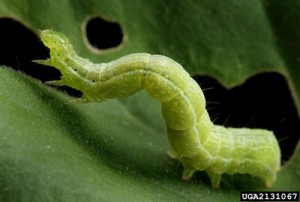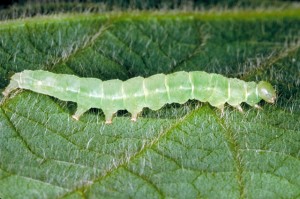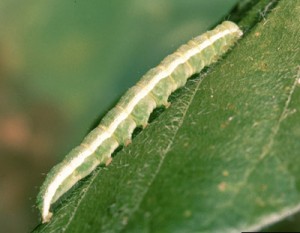In the last few weeks, I have received several calls about mid to late season soybean pests. The main questions I have been getting are, “There is a lot of defoliation damage, have I reached threshold? What do you recommend I spray?” First, we need identify what pests are present.
Three common foliage feeder pests in soybeans are velvetbean caterpillars, green cloverworms and loopers, which are the most difficult and expensive to control. This is the time of year these pests will begin to pod feed and cause defoliation damage. The threshold level needed to spray for loopers is 19 larvae per 25 sweeps and 38 larvae per sweep net for velvetbean and green cloverworm. Spraying Dimilin at a rate of 2-4 oz/acre should give good control over velvetbean and green cloverworms. If Loopers are causing most of the damage, Prevathon at a rate of 14-20 oz/acre or Intrepid at 4-8 oz/acre will work.
Lastly, knowing how to identify these worms will help you in the long run. One way I identify them is by how many abdominal prolegs they have: loopers have 2 pair of abdominal prolegs, green cloverworms have 3 and velvetbean caterpillars have 4.



Another soybean pest on the rise is stink bugs, the number one insect pest in soybean production. According to Dr. Phillip Roberts, UGA Extension Entomologist, stink bugs are typically “edge feeders” initially, but can eventually infest entire fields if not treated.
Stink bugs are most damaging during the “pod fill” stage, not only because of the physical damage they inflict but also by creating an entry site for pathogens. This damage can result in unfilled, shrunken or malformed pods, resulting in decreased yields. The threshold for stink bugs (green and/or brown) in the bloom to mid pod-fill stage is 3 stink bugs/ 25 sweeps and 9 stink bugs/25 sweeps after mid pod-fill. Spraying a Bifenthrin (Brigade or Discipline) at a rate of 2.1-6.4 oz/acre will help to control stink bug populations, keeping your plants green and prolonging harvest.
One of the most important tasks for a grower should be making the time for insect pest scouting. As stink bug and Looper numbers continue to rise, scouting is critical for identifying what pests are present and if the threshold has been reached. As the saying goes, “An ounce of prevention is worth a pound of cure.”
As always, please contact me or your local County Agent if you have any questions about soybean pests, which insecticides to use or would like me to do a sweep net test on one of your fields.